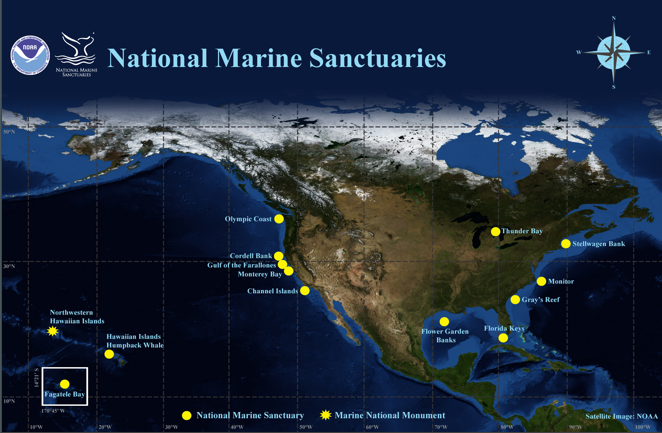Where are the National Marine Sanctuaries?
Look on the map, Which is closest to your home? Some are easier to visit than others. Which sanctuaries do you think you can visit easily? Which ones would be difficult to visit? You can learn more about your National Marine Sanctuaries by visiting us on the web at sanctuaries.noaa.gov. Tour the sanctuary encyclopedia and meet the critters that live there!

IF YOU VISIT!
Remember to use respect when visiting. Animals and plants live there and depend on you to be able to live. Learn about what wildlife might be there. How can you see it when visiting? Do I need to go on a boat? Some sanctuaries come right up to the shoreline and you can walk at the oceans edge and explore there. Tread lightly on sensitive habitats, pick up everything you bring with you, and take it back with you.
Links
Media Library and Other Information: http://marinelife.noaa.gov/
Photos: http://www.sanctuarysimon.org/photos/
General West Coast Sanctuary Information: http://www.sanctuarysimon.org/index.php
|
What are National Marine Sanctuaries?
National Marine Sanctuaries are America's underwater treasures. These areas have been identified as habitats to protect because of their extraordinary abundance of marine life and/or their importance in maritime history. Sanctuaries have regulations that allow some activities and do not allow others. For example, in sanctuaries you can boat, scuba dive, and fish, but there are special regulations to protect the sanctuaries for long term conservation. Each sanctuary has different regulations to protect the type of habitat there. What type of regulations do you think are important to protect the sanctuaries?
Challenge
Find out what is unique about each sanctuary and what regulations exist to help protect it. What would you suggest as important to protect them?
Scientists who work at the sanctuaries conduct research to learn more about the ecosystems and the organisms that make them their homes. You can't protect something you don't know about, so research is essential to understanding the sanctuaries and marine ecosystems.
Within their protected waters, giant humpback whales breed and calve their young, unique plants and animals flourish and shipwrecks tell stories of our maritime history.
Sanctuary habitats include:
- beautiful rocky reefs,
- lush kelp forests,
- coral reefs,
- whale migration corridors,
- spectacular deep-sea canyons, and
- underwater archaeological sites
Our nation's sanctuaries can provide a safe habitat for species close to extinction or protect historically significant shipwrecks. Ranging in size from less than one square mile to 137,792 square miles, each sanctuary site is a unique place needing special protections.
What can we do?
Everyone can help be good ocean stewards, no matter where they live. If you live in Kentucky, or South Dakota, you too are connected to the ocean by a watershed. Think for a minute... Where is the closest river or stream to my home? ...All rivers lead to the ocean and that means you live upstream!
When you learn about something you value, you understand it; when you understand it, you respect it; and when you respect it, you protect it.
21 things you and your family can do to protect the ocean.
- Learn all you can about the ocean and its creatures.
- Place all trash especially non-biodegradable plastics in proper receptacles.
- Puncture inflated balloons after use and dispose of properly.
- Protect wildlife by disposing of fishing lines and nets properly, not in or near the water.
- Use water sparingly when watering your lawn and washing your car as well as for all other household chores.
- Reduce or better yet eliminate the use of household non-biodegradable chemicals and detergents.
- Reduce, or better yet eliminate the use of herbicides, pesticides and fertilizers on your lawns.
- Reduce automobile pollution by using carpools, using fuel-efficient vehicles, recycling motor oil and keeping your vehicles in good working condition.
- Use plants that don't require a lot of watering and native plants to reduce the amount of water needed for home and business landscaping purposes.
- Plant trees to offset the amount of carbon dioxide for which you are personally responsible. Visit www.americanforests.org or www.betterworldclub.com or www.futureforests.com to find out what you can do.
- Turn off lights and appliances including the television when you are not in the room.
- In the summer set the thermostat at 80 degrees F or higher, and in the winter set it at 68 degrees F or lower.
- Inspect your wall outlets, windows and doors for air leaks.
- Use shades and/or curtains or insulated windows and doors to reduce heat transfers.
- Protect wildlife by not feeding sea animals including birds, sea turtles, dolphins and whales.
- Protect ocean wildlife by not disturbing the nests and nesting grounds of shore birds and sea turtles.
- Learn before you go fishing, contact your local Fish and Game office about local fishing regulations.
- Practice ethical fishing methods by learning how to properly catch and release.
- Fish only species that are not of concern, threatened or endangered.
- Know the size limits, bag limits and seasons of the fish you are catching. Several websites list state and federal regulations
- Be a smart shopper, choose your seafood responsibly. Several websites offer advice on purchasing seafood including:
- Monterey Bay Aquarium
- Audubon Society
- Seafood Choices Alliance
- The Natural Resources Defense Counsel
- Ocean Trust
- Blue Ocean Institute
National Marine Sanctuaries are kind of like the National Parks of the ocean. They are nationally and internationally significant. These areas have special regulations to ensure they will be around for our future generations to enjoy.
|





